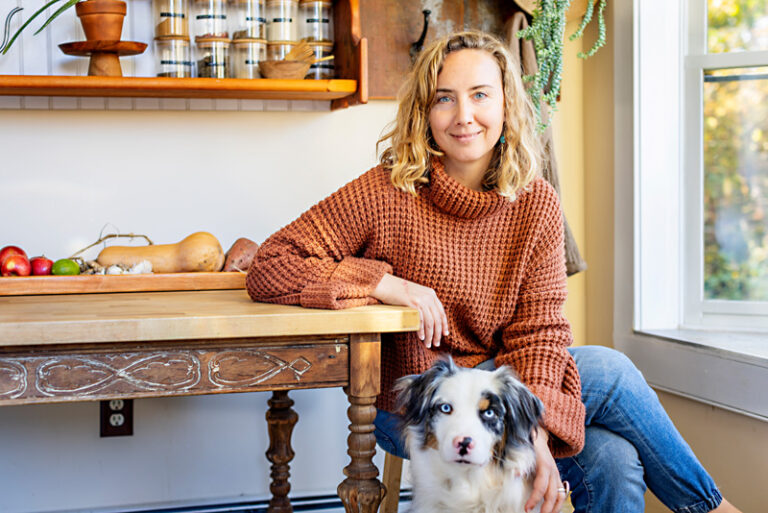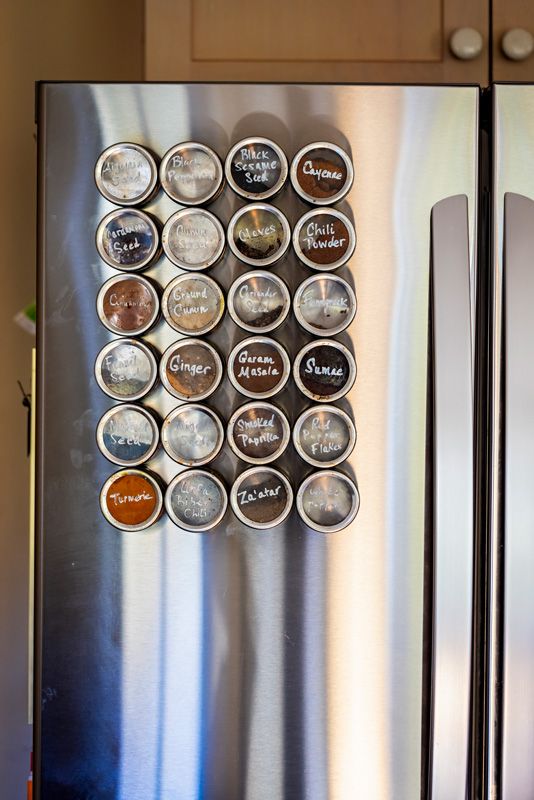
Sometimes it takes a while to find your thing. For Jacqueline Foster, it was not a question of finding but instead refining her thing. What to do with a love of food and spectacular cooking skills?
Jacqueline, who grew up in Central Massachusetts, attended Johnson & Wales Culinary School “before being a chef was a cool thing worthy of a serious and respected career.” After graduating, Jaqueline was awarded an eight-month internship cooking at Ireland’s five-star Adare Manor. “It’s a 14th-century manor. The food was very French,” Jacqueline says. “We had to set up our stations where all our prep and service was on a white linen tablecloth that had to be pristine at the end of each night.”
She stayed, traveled, and cooked in Ireland for five years. “It’s an amazing place to cook. As far as resources go, it’s incredible. It is 50 degrees and moist. There is pasture for animals to feed on year-round. The seafood is incredible.” She worked for a woman who was an Irish revivalist. The restaurant was Gaelic-speaking only. “It was across from the Irish Parliament, so the restaurant was as much about politics as it was about food.”
When Jaqueline returned to the U.S., she studied at the University of Vermont’s cheesemaking school and then got a job working for a cheesemaker in Sommerville, Mass. Soon after, the Kitchen Porch’s Jan Burhman reached out looking for a person to make cheese for her for the summer. “Jan introduced me to Caitlin Jones and Allen Healy. I worked with them for about a year and a half and developed their feta with them.” After a year and a half, Molly and Eric Glasgow offered her a job at the Grey Barn. She worked with them for four years, developing their cheeses.
“Making cheese is a kind of spiritual practice. You are working with four essential ingredients: Milk, salt, rennet, and enzymes. It’s a mixture of control and allowing. Nature and nurture. A really cool process. It activated my scientist mind. I am really grateful for that time in my life,” Jaqueline says.
Looking to change things up, Jaqueline left Grey Barn and bought a food truck, which she called Mangku. “I was using Island-grown food, trying to make healthy, accessible food. It was really fun and really challenging.” But after two years of trying to make it work, she sold the truck. “The thing that broke me down was the truck itself. The generator failed multiple times. I got pregnant and had my son Isla. I had to shut down and rethink what I wanted to do.”

Around this time, she “accidentally” attended an Ayurvedic (sounds like ai-ur-vay-duhk) workshop. “Everything connected. All the food paths had finally converged. The food systems, food as medicine, and as a chef, it all made sense. I was completely hooked. I bought every book, took workshops, and slowly started to incorporate Ayurvedic cooking practices and medicine and food into my life.”
Ayurveda is one of the oldest systems of medicine in the world. The word Ayurveda comes from the Sanskrit words “ayur” (life) and “veda” (knowledge). Translated, it means “knowledge of life.” Ayurvedic practices originated in India about 5,000 years ago and is a holistic approach to health, addressing balance in the body, mind, and spirit. Much like “Chi” in Chinese medicine, it looks at a person’s “prana” or life force. The system identifies a person’s Ayurvedic constitution, called a dosha, and then prescribes a program that includes a holistic diet based on this constitution that includes eating seasonally and using natural herbs, home practices such as tongue scraping, massaging one’s body with warm oil, oil pulling, and lifestyle practices such as yoga, meditation, and breathwork. All with the goal of bringing the body, mind, and spirit into balance.
“Ayurveda can address a myriad of ailments, from stress and anxiety to digestive disorders and chronic fatigue, by focusing on the root cause rather than just treating the symptoms. As you dive deeper into this ancient healing system, you will gain invaluable tools to proactively maintain your health, prevent illness, and foster longevity.” Jacqueline says.
Each person’s dosha is different, and may influence how well your body functions during specific seasons. For instance, the Vata dosha (air and space) is connected to the cold, dry winter. The Pitta dosha (fire) is connected to summer, and the Kapha dosha (earth and water) is connected to wet, rainy, muddy spring.
Jaqueline just finished a year-long, 600-hour program of study at the Mahatma School of Ayurveda in Vermont (she also completed a 200-hour course of study) and has a license as an Ayurvedic health counselor. She now works with clients and as a private chef, bringing this lens to cooking and living. “But even if a client is not asking for Ayurvedic food per se, I am still applying the principles no matter what,” she says. Jaqueline’s Ayurvedic offerings began to take off during the pandemic. “I would get calls like, ‘My mother is really ill. I can’t be there. Can you cook for her and bring her some food?’ Others began to reach out to have food delivered while they were being treated for cancer or to support women in their first 40 days postpartum,” Jacqueline says.

No matter what someone is looking for, Jaqueline always meets with her clients and does a thorough assessment of their needs. “I want to empower my clients. This is not about deprivation. I am not going to take things away from them. This is about positive changes. Positive results. In some cases I cook for my clients, but in most, I want to teach them so that they can do it for themselves and it is sustainable. I love that there is this simplified language and framework to work within. This is doable. Accessible. Not extreme. It’s about bringing bodies back into balance.”
Jacqueline says all of this in a gush as she stirs congee (it is Vata season) on her stove in her sunny Vineyard Haven kitchen. Having just finished an intensive year of study, Jacqueline now wants to spend some time “digesting.” She lights a ghee candle, “I always light this when cooking for clients.” And then plucks some spices from her refrigerator. She works with ease, slicing garlic on a mandolin and crisping it up in some sesame oil. When the garlic is ready, cilantro and scallions chopped, she spoons the warm rice into bowls and garnishes the congee. “I see Ayurveda as a sensory science, bringing us into deeper awareness of the qualities of everything we come into contact with. This awareness alone is deeply healing, but is the fundamental toolbox for living in harmony with the earth and all beings,” she says.
Jacqueline’s congee is an umami bomb. It hits all the right notes. Tasting her food, watching her cook, makes it clear that after years of working in different kitchens with different methods and mediums, she has found her balance. Her harmony. Her food song.
To learn more about Jacqueline’s consultations, cleanses and workshops, go to matriarchayurveda.com.
Vata Season Recipes

Winter Congee
This warming soup is gentle on the digestive system and can be used for an easy and delicious reset or as a balm when you are run down or ill. The sweet qualities of the rice and the grounding nature of the broth are very soothing to vāta dosha, as they build and nourish, ballasting health against the elements of winter. The garnishes are particularly supportive in clearing congestion and respiratory stagnation with invigorating herbs. You can double this recipe and reheat for future meals, just be sure to add more broth as it tends to congeal once it cools.
For Congee:
2 quarts Vāta bone broth or chicken or vegetable broth 4-inch piece fresh ginger, smashed 4 cups cooked Basmati rice Fresh ground black pepper to taste
For Garnish:
4 Tbsp. toasted sesame oil 6 cloves garlic, sliced paper thin sea salt, to season 3 scallions, green parts thinly sliced 1/4 cup cilantro leaves, roughly chopped Cracked black pepper, to garnish
In a medium pot, bring stock, rice, ginger, and black pepper to a boil. Reduce to a simmer, cover halfway. Let cook for 25-30 minutes or until the rice has broken down and the soup has thickened to a light porridge consistency. In a small saute pan over medium heat, heat the sesame oil until it shimmers. Add sliced garlic to the pan and stir constantly until it is golden brown. Quickly turn off the heat and remove the garlic from the pan and drain on paper towels. Season with sea salt. Reserve sesame oil. Ladle congee into bowls and garnish with toasted garlic, scallions, cilantro, a drizzle of warm sesame oil, and some more cracked black pepper.

Vāta Bone Broth
Contrary to popular belief, Ayurveda does not solely prescribe a vegetarian diet. For some constitutions or imbalances, meat is indicated for its heavy and sweet qualities. This bone broth is especially grounding for Vāta dosha and in the Vāta season of winter. But the light quality of this broth makes it easily digestible for all constitutions.
The health of our bones, hair, and nails are associated with Vāta dosha and we commonly see imbalances like arthritis and osteoporosis, dry hair, rough skin, and brittle nails or cold extremities when Vāta is aggravated. This method of making stock at such a specific temperature is borrowed from the Japanese, and used to extract the most flavor, collagen, and minerals from the bones. No salt is added because it’s simply not needed. A prominent truth of Ayurveda is: like increases like, so if we are looking to build bone strength and stabilize Vāta, why not go to the source.
You can sip this warm broth throughout the day or use it as a base in any soup, stew, or curry or the Winter Congee.
1 large (4-5 lb.) whole chicken * 2 whole cinnamon sticks 4-inch piece fresh ginger, smashed 3 star anise 2 Tbsp. black peppercorns
*Be sure to buy organic, pasture raised chicken if possible. Even better if you can get it from an Island farm.
Rinse the chicken under cold water until the water runs clear.
Put the chicken in a large, heavy-bottomed stock pot and fill with cold water so that the chicken is fully submerged. The water volume should be double the volume of chicken. Over high heat, bring the water to a boil. As soon as it reaches a boil, turn the heat down to medium-low. Skim all debris that has risen to the surface.
Add the remaining ingredients and bring the water temperature down to 176F, or just below a simmer. Hold the temperature here for at least four hours. If the temperature increases or begins to simmer, add a little cold water. Stir the pot every once in a while to assist the chicken in falling apart and extracting more minerals from the bones. After 6 hours, strain the stock through a fine mesh sieve, saving the meat for another use and discarding the carcass.
Pour into freeze-safe containers and cool uncovered and then refrigerate or freeze. The broth stays fresh for one week in the fridge and one month in the freezer.